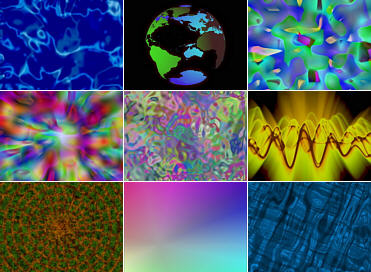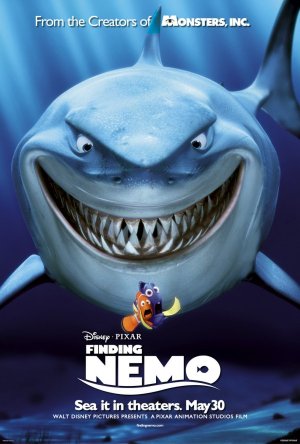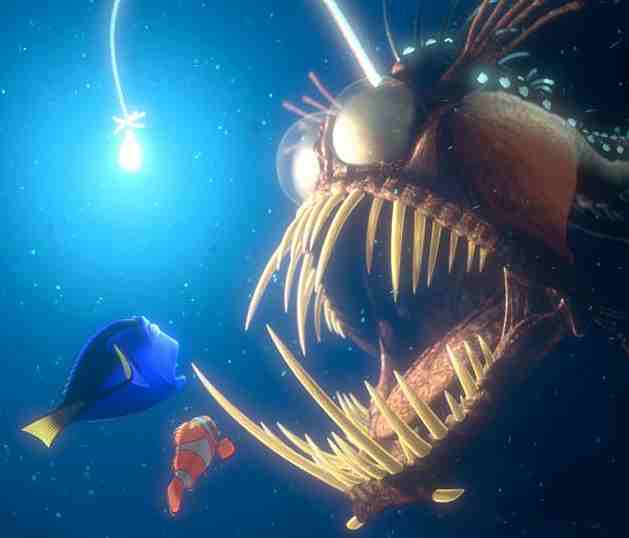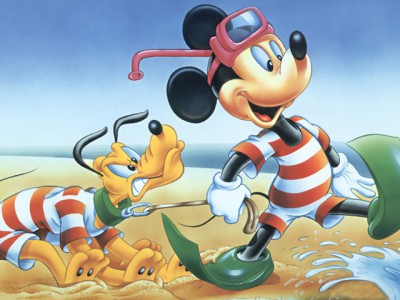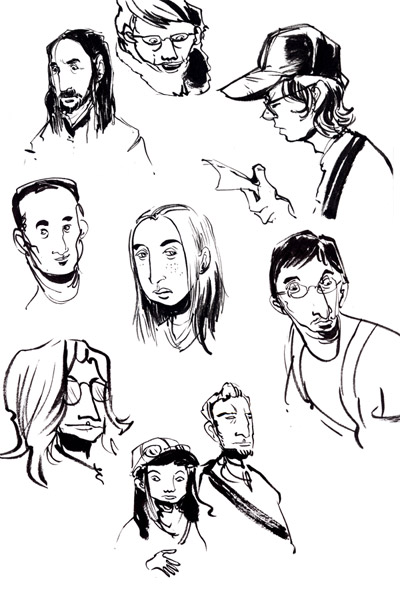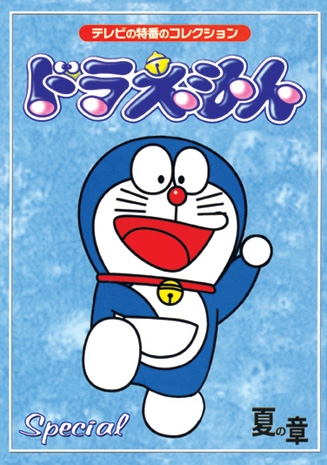
Doraemon (ドラえもん?) is a Japanese manga series created by Fujiko F. Fujio (the pen name of Hiroshi Fujimoto) and Fujiko A. Fujio (the pen name of Motō Abiko) which later became an anime series and Asian franchise. The series is about a robotic cat named Doraemon, who travels back in time from the 22nd century to aid a schoolboy, Nobita Nobi (野比 のび太, Nobi Nobita?).
The series first appeared in December 1969, when it was published simultaneously in six different magazines. In total, 1,344 stories were created in the original series, which are published by Shogakukan under the Tentōmushi (てんとう虫?) manga brand, extending to forty-five volumes. The volumes are collected in the Takaoka Central Library in Toyama, Japan. Fujio was born in Toyama.
A majority of Doraemon episodes are comedies with moral lessons regarding values such as integrity, perseverance, courage, family and respect for elders. Several noteworthy environmental issues are often visited, including homeless animals, endangered species, deforestation, and pollution. Topics such as dinosaurs, the flat Earth theory, wormhole traveling, Gulliver's Travels, and the history of Japan are often covered.
Doraemon was awarded the Japan Cartoonists Association Award for excellence in 1973. Doraemon was awarded the first Shogakukan Manga Award for children's manga in 1982,[5] and the first Osamu Tezuka Culture Award in 1997. In March 2008, Japan's Foreign Ministry appointed Doraemon as the nation's first "anime ambassador."[6] Ministry spokesman explained the novel decision as an attempt to help people in other countries to understand Japanese anime better and to deepen their interest in Japanese culture."[7] The Foreign Ministry action confirms that Doraemon has come to be considered a Japanese cultural icon. In 2002, the anime character was acclaimed as an Asian Hero in a special feature survey conducted by Time Asia magazine.[8]
In December 1969, the Doraemon manga appeared simultaneously in six different children's monthly magazines. The magazines were titled by the year of children's studies, which included Yoiko (good children), Yōchien (nursery school), and Shogaku Ichinensei (first grade of primary school) to Shogaku Yonnensei (fourth grade of primary school). By 1973, the series began to appear in two more magazines, Shogaku Gonensei (fifth grade of primary school) and Shogaku Rokunensei (sixth grade of primary school). The stories featured in each of the magazines were different, meaning the author was originally creating more than six stories each month. In 1977, CoroCoro Comic was launched as a magazine of Doraemon. Original manga based on the Doraemon movies were also released in CoroCoro Comic. The stories which are preserved under the Tentōmushi brand are the stories found in these magazines.
Since the debut of Doraemon in 1969, the stories have been selectively collected into forty-five books published from 1974 to 1996, which had a circulation of over 80 million in 1992. In addition, Doraemon has appeared in a variety of manga series by Shōgakukan. In 2005, Shōgakukan published a series of five more manga volumes under the title Doraemon+ (Doraemon Plus), which were not found in the forty-five Tentōmushi pipi volumes. Many other series have since been produced, some not from official supplies.
Plot summary
The first appearance of Doraemon, who came via the time machine.
Doraemon is sent back in time by Nobita Nobi's great-great grandson Sewashi to improve Nobita's circumstances so that his descendants may enjoy a better future. In the original timeline, Nobita experienced nothing but misery and misfortune throughout his life. As a result of this, Nobita's failures in school and subsequently, his career, have left his family line beset with financial problems. In order to alter history and better the Nobi family's fortunes, Sewashi sent him a robot called Doraemon.
Doraemon has a pocket from which he produces many gadgets, medicines, and tools from the future. The pocket is called yojigen-pocket, or 4-dimensional pocket.
Although he can hear perfectly well, Doraemon has no ears: his robotic ears were eaten by a mouse, giving him a series-long phobia of the creatures.
The stories are formulaic, usually focused on the everyday struggles of fourth grader Nobita, the protagonist of the story. In a typical chapter, Nobita comes home crying about a problem he faces in school and/or the local neighborhood. After hearing him out, Doraemon always offers helpful advice to his problem(s), but that's never enough for Nobita, who is consistently looking for the "quick, easy" way out (which offers insight to the viewers as to why Nobita's life turned out the way it did). Finally, after Nobita's pleading and/or goading, Doraemon produces a futuristic gadget out of his aforementioned pouch to help Nobita fix his problem, enact revenge, or flaunt to his friends.
Nobita usually goes too far, despite Doraemon's best intentions and warnings, and gets into deeper trouble than before. Sometimes, Nobita's friends (usually Suneo or Jaian) steal the gadgets and end up misusing them. However, by the end of the story, there is usually retribution to the characters who end up misusing them, and a moral is taught.
Series finale rumors
There are three current and often quoted urban legends that started spreading in late 1980s of an ending to the Doraemon series.
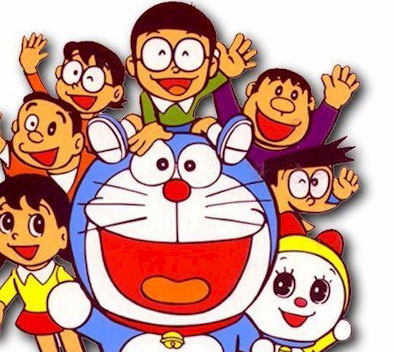
* The first and the most optimistic ending was made public by Nobuo Sato several years ago. Doraemon's battery power ran out, and Nobita was given a choice between replacing the battery inside a frozen Doraemon, which would cause it to reset and lose all memory, or await a competent robotics technician who would be able to resurrect the cat-robot one day. Nobita swore that very day to work hard in school, graduate with honors, and become that robotics technician. He successfully resurrected Doraemon in the future as a robotics professor, became successful as an AI developer, and thus lived happily ever after, thus relieving his progeny of the financial burdens that caused Doraemon to be sent to his space-time in the first place. A dōjin manga for this ending was made by a "Tajima T Yasue" in 2005, and it sold 13,000 copies before Shogakukan halted its publication. Tajima apologized to Shogakukan in 2007 and paid an undisclosed amount of money for settlement.[9]
* The second, more pessimistic ending suggests that Nobita Nobi is suffering from autism and that all the characters (including Doraemon) are simply his delusion. The idea that Nobita was a sick and dying little boy who imagined the entire series on his sickbed to help him ease his pain and depression no doubt angered quite a lot of fans. Many Japanese fans staged a protest outside the headquarters of the publisher of the series after learning about this suggestion. The publisher had to issue a public statement that this is not true. (This ending actually correlates to the ending for the series St. Elsewhere, which ended in 1988.)
* The third ending suggests that Nobita fell and hit his head on a rock. He fell into a deep coma, and eventually into a semi-vegetative state. To raise money for an operation to save Nobita, Doraemon sold all the tools and devices in his four-dimensional pocket. However, the operation failed. Doraemon sold all his tools except for one used as a last resort. He used it to enable Nobita to go wherever he wanted, whichever time or era he wished to go. In the end, the very place Nobita wanted to go was heaven.
The plausibility of these issues was discussed here and it was concluded that there is no ending to Doraemon.[10]
There are three official endings to Doraemon that were made. Doraemon was discontinued in two media because readers were advancing in grades and an ending was believed to be needed. These two are not reprinted.
* In the March 1971 issue of the magazine Shogaku 4-nensei:[11] Due to the fact that visitors from the future were causing too much trouble, the government in the 22nd Century passed a bill to ban time-travelling altogether, meaning Doraemon would have to return to his time era. He leaves Nobita.
* In the March 1972 issue of the magazine Shogaku 4-nensei: Doraemon, for some reason, had to go back to the future but fakes a mechanical problem so that Nobita would let him go. Nobita believes him and promises to wait until Doraemon gets well. Realizing that Nobita can handle his departure, Doraemon tells the truth and Nobita accepts. Doraemon returns to the future.
The third ending was actually meant to be the official ending due to low TV ratings and the Fujiko Fujio duo being busy with other works, but Doraemon did not leave their minds and restarted in the next month's issue. In 1981, this episode was made into anime (called "Doraemon Comes Back"), and in 1998, this was released as an anime movie.
* In the March 1973 issue of the magazine Shogaku 4-nensei, Nobita again returns home after losing a fight against Gian. Doraemon then explains that he has to return. Nobita tries to have Doraemon stay but after talking it over with his parents, he accepts Doraemon's departure. They take a last walk in the park. After they split up, Nobita encounters Gian and gets into a fight again. After a long duel with Nobita trying to win at all costs so that Doraemon can leave without worries, Gian gave up (which gave Nobita the win) because no matter what, Nobita refuses to stay down. Doraemon finds Nobita passed out with a bloody mouth and takes him home. Sitting beside the sleeping Nobita, Doraemon returns to the future. This story was reprinted in the last chapter of the manga Book 6.

* The animated version is very similar, but lengthened. Nobita finds a box the shape of Doraemon in his drawer. The next day, which happens to be April Fool's Day, Nobita is jeered at by Suneo and Gian, the latter tricking him about Doraemon's return. He happily runs home and asked his mother whether Doraemon came back and finds out the truth. Nobita couldn't stand it and opens the box. Inside of it was a bottle of liquid. He hears Doraemon's voice explaining that the potion is called Uso 800 (Lies 800) it is used to make all untruths the drinker says true. Nobita uses it to play a few tricks on Gian and Suneo, like first taking cover then say that the weather sure is good, which becomes a lie and it started to rain heavily before he said it is raining heavily and the rain stopped. Gian and Suneo was scared away after a few tricks and when Nobita mentioned what is happening. Nobita was very happy at first but quickly loses interest in the absence of Doraemon. As he walks home, due to his earlier questioning if Doraemon returned or not, his mother asked him if he could find Doraemon, he unwittingly said, in great disappointment, the truth about Doraemon never coming back, just like what Doraemon told Nobita before his departure. Since the potion was still in effect, when he arrives his room he finds Doraemon there, and they have a happy reunion, but due to the effects of the potion, all his greets and joyful words have to be spoken in the opposite way like I am so unhappy that we can never be together again.. The extended ending from the animated series was eventually adapted to the first story of Book 7 in the manga series, with a few changes (i.e. Instead of hearing Doraemon's voice explaining the use of the potion, he finds a card inside the box describing the use of the potion).
When the Fujiko Fujio duo broke up in 1987, the very idea of an official ending to the series was never discussed. Since Fujiko F. died in 1996 before any decisions were reached, any "endings" of Doraemon are fan fiction. However, it is apparent from many episodes and movies where Nobita travels to the future that in the end he does marry Shizuka, leads a happy life and separates with Doraemon, although Nobita and his friends fondly remember him.[12]
 Growing up from the US, most kids have grown up with cartoons such as Bugs Bunny and Popeye which portrays the good overcoming evil as well as satires that pokes fun of political figures in a none threatening way. For kids, the majority of the time these cartoons have provided a positive impact rather then negativity or problems.
Growing up from the US, most kids have grown up with cartoons such as Bugs Bunny and Popeye which portrays the good overcoming evil as well as satires that pokes fun of political figures in a none threatening way. For kids, the majority of the time these cartoons have provided a positive impact rather then negativity or problems.













